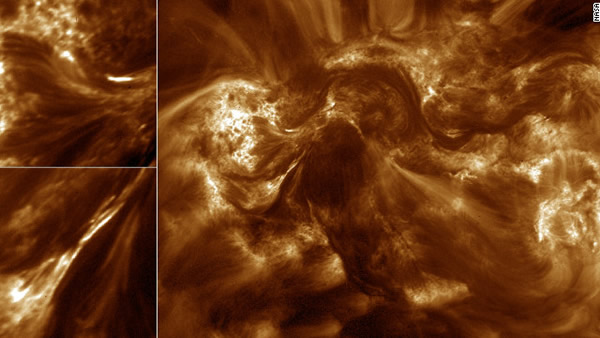Magnetic 'Braids' May Cook the Sun's Corona
The Solar Dynamics Observatory (SDO) captured an image
Scientists have long puzzled over why the surface of the sun is cooler than its corona, the outer hazy atmosphere visible during a solar eclipse. Now thanks to a five-minute observation by a small, but very high-resolution ultraviolet telescope they have some answers.
Even before the July 2012 launch of the High-resolution Coronal Imager, nicknamed Hi-C, scientists suspected that magnetic fields on the sun were responsible for ramping up its energy, resulting in a flaring corona that can reach 7 million degrees Fahrenheit, compared to a visible solar surface temperature of about 10,000 degrees.
Hi-C, which was launched aboard a suborbital rocket to study the sun without interference from Earth's atmosphere, revealed interwoven magnetic fields braided like hair. When the braids relaxed, they released energy.
"I had no idea we would see structures like that in the corona. Seeing these braids was very new to me," astrophysicist Jonathan Cirtain with NASA's Marshall Space Flight Center in Huntsville, Ala., told Discovery News.
"Magnetic braiding" is believed to happen when small bundles of magnetic fields become wrapped around each other due to plasma moving around on the sun's surface.
Follow-up observations are needed to learn if the braiding phenomenon is widespread and how important is it to coronal heating.
"Are twisted-up field lines just all over the place? Do they only happen near 'inversion layers,' where you go from a positive net flux out from the sun's surface to negative net flux into the surface? How prevalent is this structure to the overall sun and how important is it to heating the sun's atmosphere? I think that's the next step that we will take," Cirtain said.
"You are not going to solve a problem with five minutes of data," added space scientist and physicist Peter Cargill, with Imperial College London, who isn't associated with this research.
"A rocket flight like this is primarily designed to demonstrate new technology. You hope to get some good science, as they have done, and to point the way toward what to look for when such an instrument flies on a spacecraft," Cargill wrote in an email to Discovery News.
Hi-C had the precision to see the equivalent of something the size of a dime from 10 miles away, allowing astronomers to observe details in extreme ultraviolet light of structures on the sun that were about 100 miles in diameter -- five times better than the resolution of the next-best instrument, the Atmospheric Imaging Assembly aboard NASA's ongoing Solar Dynamics Observatory mission.
The observation was tricky and short. Cirtain said he remotely operated the telescope during flight to home in on a particularly active region of the sun to photograph. The telescope, which was launched from the White Sands Missile Range in New Mexico, then parachuted back to the desert so its onboard data could be recovered and analyzed.
In addition to imaging the small-scale physics of the corona, the research is expected to enrich forecast models for space weather -- a phenomenon that can impact satellites, power girds and other electronics around and on Earth.
"The corona is really the formative location for space weather. If we want to understand how the sun, how stars work in general, that’s very important to understand how the universe is put together, but more important in your day-to-day life is the implication space weather has on our technology and our planet. Space weather has economic impacts that haven't been recognized until recently," Cirtain said.
The research is published in this week's Nature.
Jan 23, 2013 by Irene Klotz












